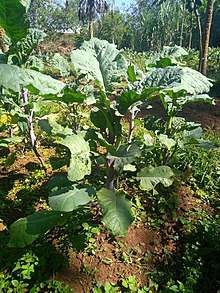Brassica carinata
Brassica carinata (Ethiopian rape,[1] Ethiopian mustard, Abyssinian mustard) is a member of the genus Brassica. It is believed to be a hybrid between Brassica nigra and Brassica oleracea.[2]
| Brassica carinata | |
|---|---|
 | |
| Scientific classification | |
| Kingdom: | Plantae |
| Clade: | Tracheophytes |
| Clade: | Angiosperms |
| Clade: | Eudicots |
| Clade: | Rosids |
| Order: | Brassicales |
| Family: | Brassicaceae |
| Genus: | Brassica |
| Species: | B. carinata |
| Binomial name | |
| Brassica carinata A.Braun | |
The flowers attract honey bees to collect pollen and nectar.
Leaf uses
The plant has a mild flavor, and is eaten as a leaf vegetable. It is known as habesha gomen, (Ethiopic: ሐበሻ ጎመን) in Amharic.[3] Named varieties include Texsel, which is particularly adapted to temperate climates.[4]
Seed uses
Although Brassica carinata is cultivated as an oilseed crop in Ethiopia,[5] it has high levels of undesirable glucosinolates and erucic acid.[6] The closely related Brassica napus (Rapeseed) is considered a better oilseed crop in comparison.
Brassica carinata has been used to develop an aviation biofuel for jet engines.[7] On October 29, 2012, the first flight of a jet aircraft powered completely by biofuel, made from Brassica carinata, was completed.[8][9] The byproduct of Brassica carinata oil production is utilized in protein meal for animal fodder.[10]
References
- "BSBI List 2007". Botanical Society of Britain and Ireland. Archived from the original (xls) on 2015-01-25. Retrieved 2014-10-17.
- Prakash, S. and Hinata, K. (1980), "Taxonomy, cytogenetics and origin of crop Brassicas, a review", Opera Botanica, 55:1-57
- Zemede Asfaw, "Conservation and use of traditional vegetables in Ethiopia" Archived 2012-07-07 at the Wayback Machine, Proceedings of the IPGRI International Workshop on Genetic Resources of Traditional Vegetables in Africa (Nairobi, 29–31 August 1995)
- Plants for a Future (2008-06-10). "Brassica carinata".
- Alemaheyu, N. and Becker, H. (2002), "Genotypic diversity and patterns of variation in a germplasm material of Ethiopian mustard (Brassica carinata A. Braun)", Genetic Resources and Crop Evolution, 49(6):573-582
- Getinet, A., Rakow, G., Raney, J. P. and Downey, R. K.(1997) "Glucosinolate content in interspecific crosses of Brassica carinata with B. juncea and B. napus", Plant Breeding 116 (1):39–46
- Lane, James (18 April 2012), "Tinker, tailor, sailor, fly", BioFuels Digest, retrieved 31 January 2015
- http://www.asdnews.com/news-46032/First_solely-biofuel_jet_flight_raises_clean_travel_hopes.htm
- "NRC Flies World's First Civil Jet Powered by 100 Percent Biofuel". Aero-news Network. 7 November 2012. Retrieved 21 November 2012.
- Pratt, Sean (11 May 2017). "Firm eager to ride the 'canola train' with carinata". The Western Producer. Retrieved 29 January 2018.